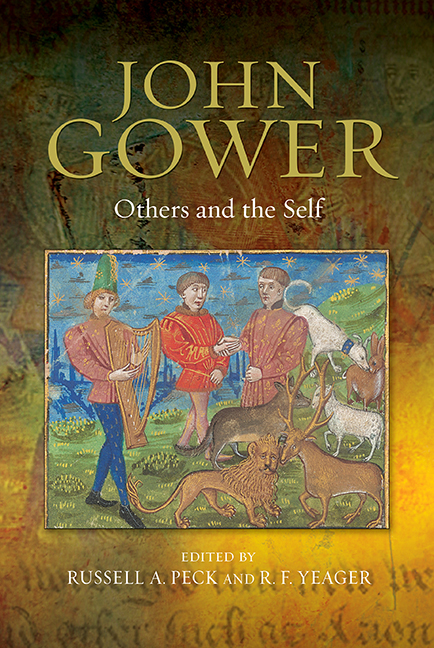Book contents
- Frontmatter
- Contents
- List of Illustrations
- Abbreviations
- Introduction
- PART I KNOWING THE SELF AND OTHERS
- PART II THE ESSENCE OF STRANGERS
- 6 Sensation and the Plain Style in John Gower's Confessio Amantis
- 7 Violence without Warning: Sympathetic Villains and Gower's Crafting of Ovidian Narrative
- 8 Gower, Lydgate, and Incest
- 9 Gower's Jews
- 10 Letters of Old Age: The Advocacy of Peace in the Works of John Gower and Philippe de Mézières
- PART III SOCIAL ETHICS, ETHICAL POETICS
- Bibliography
- Index
- VOLUMES ALREADY PUBLISHED
8 - Gower, Lydgate, and Incest
from PART II - THE ESSENCE OF STRANGERS
Published online by Cambridge University Press: 30 April 2019
- Frontmatter
- Contents
- List of Illustrations
- Abbreviations
- Introduction
- PART I KNOWING THE SELF AND OTHERS
- PART II THE ESSENCE OF STRANGERS
- 6 Sensation and the Plain Style in John Gower's Confessio Amantis
- 7 Violence without Warning: Sympathetic Villains and Gower's Crafting of Ovidian Narrative
- 8 Gower, Lydgate, and Incest
- 9 Gower's Jews
- 10 Letters of Old Age: The Advocacy of Peace in the Works of John Gower and Philippe de Mézières
- PART III SOCIAL ETHICS, ETHICAL POETICS
- Bibliography
- Index
- VOLUMES ALREADY PUBLISHED
Summary
I want to begin with two classic observations about incest and medieval cultural attitudes. The first will be known to anyone with even a passing familiarity with Gower scholarship. G. C. Macaulay opens his editor's notes on Book VIII of the Confessio Amantis by remarking: “We may suppose that our author had some embarrassment as regards the subject of his eighth book.” He goes on to suggest that Gower made incest the seventh deadly sin rather than lechery as he had somewhat improvidently already treated most of the other subcategories of the sin in earlier books. At the distance of a century-plus, it is fairly easy to see the embarrassment here is Macaulay's rather than Gower's. It may be ours as well, although probably in a different sense than Macaulay intended. Gower's prominent interest in incest may have embarrassed his readers from the very beginning. We can find a certain anxiety in the first recorded reaction to the Confessio. I refer, of course, to the distaste for the tales of Canace and Machaire and Apollonius expressed by one of Gower's contemporaries, a fellow Londoner, fellow poet, and a socialclimbing bureaucrat to whom posterity has been somewhat kinder than it has to Gower. To help us begin to come to conceptual grips with this challenging aspect of Gower's work, I turn to my second citation.
While the citation itself may not be as familiar to Gower scholars as Macaulay's remark, the sentiment it expresses certainly will be. It comes from the great psychoanalyst, Otto Rank. Rank begins the chapter on the Middle Ages in his epic 1912 study, The Incest Theme in Literature and Legend as follows:
Like antiquity, the Christian Middle Ages are rich in popular stories, legends, and literary works dealing with the incest theme in its many guises […]. Although […] partially influenced by the traditions of antiquity, the continual assimilation of these themes and their special treatment under the influence of the Christian worldview demonstrate the active unconscious role of narrator and listener in these stories, which differ displeasingly from the naive antique traditions in their voluptuous and torrid fantasies.
- Type
- Chapter
- Information
- John Gower: Others and the Self , pp. 156 - 182Publisher: Boydell & BrewerPrint publication year: 2017

